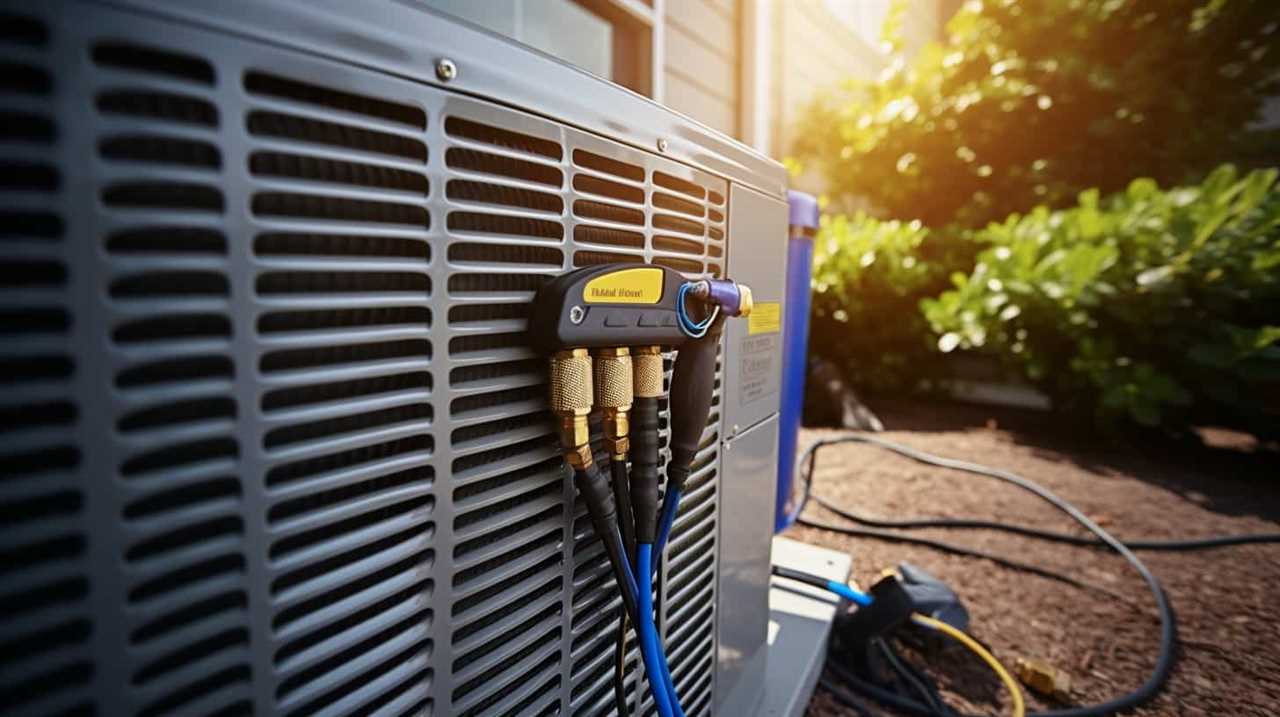As we move towards a more sustainable future, it is essential to grasp the consequences of our energy decisions.
In this guide, we explore the environmental consequences of heat pump energy use and how it can contribute to a greener world. By evaluating our carbon footprint and adopting sustainable practices, we can reduce the environmental impact of heat pump systems.
Join us as we delve into the world of eco-friendly alternatives and discover low-environmental impact heat pump technologies.
Together, let’s make a difference.

Key Takeaways
- Assess energy efficiency of heat pumps and identify areas for improvement
- Incorporate renewable energy sources to reduce carbon emissions and achieve energy independence
- Optimize insulation, schedule regular maintenance, and install programmable thermostats for maximum energy efficiency and minimal environmental impact
- Geothermal heating and cooling systems significantly reduce greenhouse gas emissions, lower energy consumption, and contribute to a cleaner environment. They also provide long-term cost savings and potential government incentives.
Energy Efficiency: Understanding the Impact on the Environment
We frequently assess the energy efficiency of heat pumps to understand their impact on the environment. Energy consumption is a crucial aspect to consider when it comes to environmental conservation. By evaluating the efficiency of heat pumps, we can determine how effectively they convert energy into useful heat, thus minimizing wastage.
This assessment allows us to identify areas for improvement and make informed decisions about selecting energy-efficient heat pumps that consume less energy and reduce our carbon footprint. It’s essential to prioritize energy efficiency in heat pumps as it directly impacts the environment. By choosing models with higher efficiency ratings, we can significantly reduce our energy consumption and contribute to the overall goal of environmental conservation.
Renewable Energy Sources: Promoting a Greener Heat Pump System
By incorporating renewable energy sources, we can actively promote a greener heat pump system. Renewable energy integration offers numerous environmental benefits, making it a compelling choice for heating and cooling our homes.
Here are four key reasons why it’s essential to embrace renewable energy sources in our heat pump systems:

-
Reduced carbon emissions: Renewable energy sources such as solar and wind power produce little to no carbon emissions, significantly reducing the environmental impact compared to traditional fossil fuel-based energy sources.
-
Energy independence: By harnessing renewable energy, we become less reliant on finite resources and vulnerable to price fluctuations, ensuring a more stable and sustainable energy future.
-
Lower operating costs: Renewable energy sources are becoming increasingly cost-effective, leading to potential long-term savings on energy bills.
-
Improved air quality: Traditional heating systems often release pollutants into the air, contributing to poor air quality. Renewable energy integration in heat pump systems helps mitigate these harmful emissions, resulting in cleaner and healthier indoor and outdoor environments.

Carbon Footprint: Evaluating the Environmental Consequences of Heat Pump Energy Use
When evaluating the environmental consequences of heat pump energy use, it’s important to consider the carbon footprint associated with the system. To determine the carbon footprint, evaluating methods and analyzing data are crucial steps.
By assessing the amount of greenhouse gas emissions produced throughout the life cycle of a heat pump, we can understand its environmental impact. This includes considering the energy used during manufacturing, operation, and disposal of the system. Analyzing data on electricity generation sources is also necessary, as the carbon intensity of the electricity used by the heat pump will affect its overall carbon footprint.
By understanding the carbon footprint of heat pump systems, we can make informed decisions to minimize their environmental impact.
Transitioning into the next section, let’s explore sustainable practices that can further reduce the environmental impact of heat pump systems.

Sustainable Practices: Reducing Environmental Impact With Heat Pump Systems
To reduce the environmental impact of heat pump systems, we can implement sustainable practices. Here are four energy-saving tips and green building practices that can help minimize the environmental footprint of heat pump systems:
-
Optimize insulation: Properly insulating your home or building can reduce heat loss or gain, allowing the heat pump to operate more efficiently.
-
Regular maintenance: Schedule regular maintenance for your heat pump system to ensure it’s running at peak efficiency, reducing energy consumption and extending its lifespan.
-
Smart thermostat control: Install a programmable or smart thermostat to optimize temperature settings and reduce energy usage when heating or cooling isn’t necessary.

-
Renewable energy sources: Consider powering your heat pump system with renewable energy sources, such as solar panels or wind turbines, to further reduce its environmental impact.
By implementing these sustainable practices, we can maximize energy efficiency and minimize the environmental impact of heat pump systems.
Transitioning to the next section, let’s explore eco-friendly alternatives: low-environmental impact heat pump technologies.
Eco-Friendly Alternatives: Exploring Low-Environmental Impact Heat Pump Technologies
Let’s explore the eco-friendly alternatives and technologies that offer low-environmental impact in heat pump systems.

One such alternative is geothermal heating, which utilizes the Earth’s natural heat to warm and cool buildings. Geothermal systems work by extracting heat from the ground during the winter and transferring it indoors, while during the summer, they absorb heat from the building and release it into the ground.
This sustainable practice significantly reduces greenhouse gas emissions and energy consumption compared to traditional heating and cooling methods. Geothermal systems are also compatible with green building practices, as they promote energy efficiency and reduce reliance on fossil fuels.
Frequently Asked Questions
Are There Any Financial Incentives or Rebates Available for Installing a Heat Pump System?
Yes, there are financial incentives and rebates available for heat pump installation. These incentives can help offset the initial cost and make it more affordable to switch to a heat pump system.
How Long Does a Typical Heat Pump System Last Before Needing to Be Replaced?
Typical lifespan of a heat pump system varies depending on usage and maintenance. It generally lasts around 10-15 years before needing replacement. Regular maintenance can extend the lifespan and improve efficiency.

Can a Heat Pump System Be Used to Both Cool and Heat a Home or Building?
Yes, a heat pump system can both cool and heat a home or building. It provides efficient cooling during hot months and heating during cold months. This dual functionality reduces environmental impact and increases energy efficiency.
Are There Any Potential Health Risks Associated With Heat Pump Systems?
There might be potential health risks associated with heat pump systems. It’s important to consider the environmental impact and take measures to ensure the safety and well-being of those using the system.
What Are the Maintenance Requirements for a Heat Pump System?
Maintenance requirements for a heat pump system include regular filter cleaning, checking refrigerant levels, and inspecting electrical connections. Troubleshooting tips may involve checking for air leaks, ensuring proper thermostat settings, and scheduling professional service annually.
Conclusion
In conclusion, heat pump systems offer a greener and more sustainable alternative for heating and cooling our homes. By harnessing renewable energy sources and practicing energy efficiency, we can reduce our carbon footprint and minimize environmental impact. These eco-friendly alternatives not only benefit the planet, but also provide us with a comfortable living environment.

So let’s embrace this technology and pave the way for a brighter and more energy-efficient future. Like a breath of fresh air, heat pumps bring a refreshing change to our homes and our planet.









